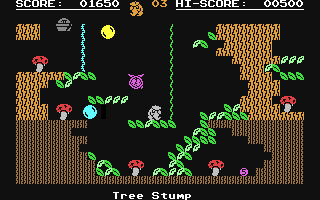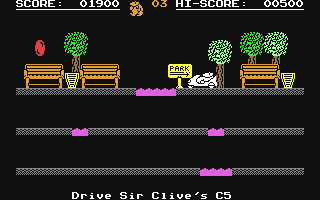|
Remember Monty Mole? The hero who went out collecting
coal and got sent to prison because of it. We-e-e-ll,
he's back again, a fugitive this time and running from
the boys in blue in this game converted from Peter Harrap's
Spectrum version.
Cutting
short his time in clink, Monty, with the aid of Sam
Stoat, escaped and now it's up to you to help him find
a boat so he can sail away (probably to meet his good
ol' pal Ronnie Biggs). When legging it from the prison,
Monty, in his haste, must've taken a wrong turning.
It's too late to do anything about it now, and with
the law on his tail (do moles have tails?) he has to
enter a rather odd-looking building. This is where you
take over and the adventure really begins.

The
actual screens (there are around 48) are standard Monty
Mole platform specials with piles of 'orrible thingies
a-zoom-ing around the place. As you will instantly see,
Monty took a fitness course in prison and he now somersaults
in true Impossible Mission style instead of jumping.
When
you start the game you are given the chance to select
a freedom kit of five objects from a pool of
twenty. The objects chosen HAVE to be correct, otherwise
you won't be able to complete certain screens and therefore
the game.
Once
the freedom kit has been selected it's on with the game.
The screens are explored in Jet Set Willy style
and objects have to be picked up. If you don't pick
them up then the game can't be solved -- unfortunately
some objects are useless to you and some are positively
harmful, but you won't know that until it's too late,
but afterwards you won't forget, will you?

There
are plenty of hazards, like crushers (carried over from
Wanted: Monty Mole) which pound up and down,
and other sneaky traps that you can discover for yourself
(he he he). What would a platform game be without humourous
denizens you may ask? Don't worry, there's loads floating
about the place and they certainly make the going tough.
All sorts of oddities like floating mugs, wasps, Things
on some Springs, hands, blobbies, amoeboids, jellyites
and other characters that are really weird. Mind you,
nothing seems weird in a game with an athletic, somersaulting
mole!
The
screens are all named and you start off in The House
and soon progress to places like the Sewerage
Works and the UItimate Experience. As you
go further into the game there are teletransporters
and lifts, Troopa Truck-like screens and - and
. . . 'nuff said.
Solving
the game takes some time as there are plenty of puzzles
and traps to keep you amused for hours, and with sussing
out the freedom kit Monty on the Run certainly
will be a tough one to crack.
TURN
THE MUSIC UP
One
of the most striking features of Monty on the Run
is its funky bop, I mean listen and dig that groove
baby. Having had quite an earful (monitors at full volume)
ZZAP! thought it was high time Commodore synth musicians
received some acclaim, so Jaz 'my Walkman is so-o-o
loud' Rignall gave Rob Hubbard, composer of the
Monty music a
bell . . .
Rob
Hubbard is thirty years old and has been in the music
biz since he left school. After hearing the music from
Activision's Master of the Lamps and Rock
'n' BoIt he felt inspired enough to start experimenting
with the 64's SID chip and consequently connected his
black and white monitor to his hi-fi and started to
program his own music utility. When asked whether he
used any professional utility he said that he felt that
most of the utilities available are very limited with
the sounds you can create. His own utility has been
perfected over the last four months and he constantly
makes changes to it so he can customize sounds and incorporate
them into his music.
Some
of his early work includes the music to Mastertronic's
Action Biker, Confusion and Thing on
a Spring. Monty he considers as one of his
best pieces to date but thinks the new piece of music
he's composing for Adventure International is going
to be a lot better, complete with blue grass banjoes,
fiddles and a drunken violin.
Most
of his music is sketched out on an old Casio MT3O synth,
but also has a Casio DX7 which he says is a lot better.
Once the tune has been worked out it's over to the 64
to start experimenting. During some tinkering he's even
accidentally stumbled upon some of the voices used in
Monty, although something like the drum sounds
(trying to emulate a Simmonds drum sound) took two weeks
to perfect.
He
feels that he's getting near to the limits of the 64
sound chip and also finds the three channels rather
limiting . . . never mind, perhaps the new Commodore
Amiga with it's eight-channel stereo sound will keep
him happily making computer music for a few more years
to come!
|